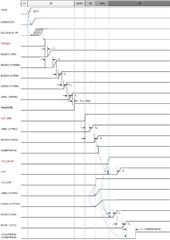Hello Sir:
We have abnormal output voltage on Buck4.
The key question is that we need to boot up in low temperature, such as 0 degree.
When 0 degree that buck 4 output voltage was dropped.
Then we followed up the preview posted as below.
That Kevin mentioned, I tried that two ways, linking it with a regulator and linking with temperature.
Linking with a regulator:
Tested results shows below.
1. Buck1-VCC0_CPU, default output voltage is 0.97V, and we added a external power supply up to 1.2V, that system and PMIC were not shutdown.
2. Buck2-VGG, default output voltage is 0.97V, and we added a external power supply up to 1.2V, that system and PMIC were not shutdown.
3. Buck3-VIN, default output voltage is 1.01V, and we added a external power supply up to 1.15V, that system and PMIC were shutdown. (Spec max voltage is 1.1025V)
4. Buck4-+V1P05A, default output voltage is 1.03V, and we added a external power supply up to 1.16V, that system and PMIC were shutdown. (Spec max voltage is 1.1025V)
5. Buck5-+V1P8A, default output voltage is 1.78V, and we added a external power supply up to 1.96V, that system and PMIC were shutdown. (Spec max voltage is 1.89V)
6. Buck6-VDDQ(DDR), default output voltage is 1.34V, and we added a external power supply up to 1.52V, that system and PMIC were not shutdown.
According that tested results only buck 3~5 were shutdown, but their external voltage were over spec,
If only provide over default voltage + 20mV, that PMIC and system will not shutdown.
Linking with temperature:
When operating in low temperature about 3~0 degree, buck 4 output voltage was dropped that will effect our system cannot boot up.
It's happen more than normal temperature.
Can you provide more recommendations and let us know how to check this issue?
If you need layout and schematic please let us know.
Thanks a lot.






